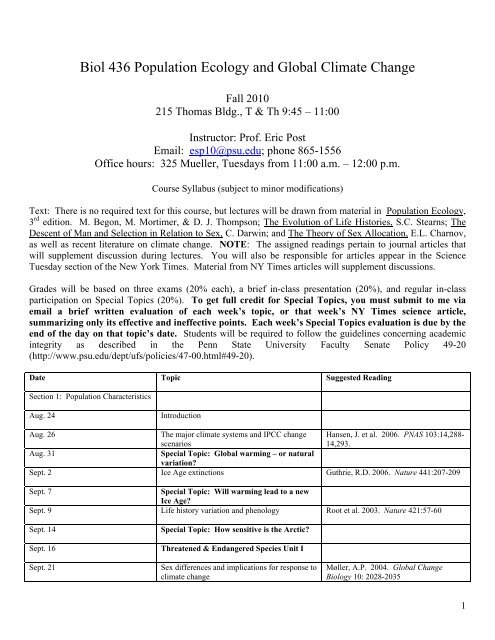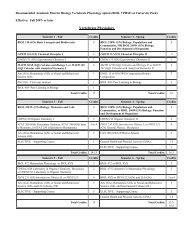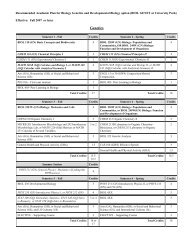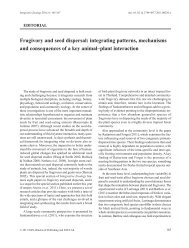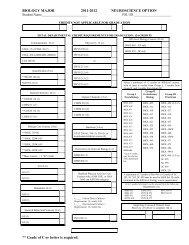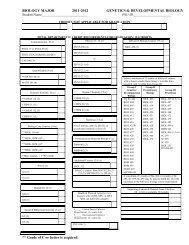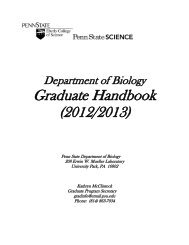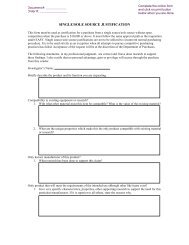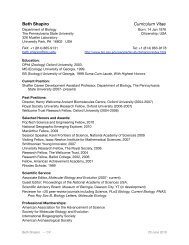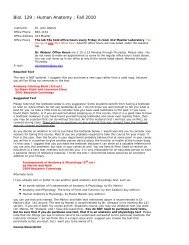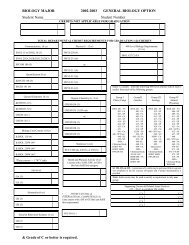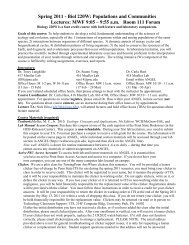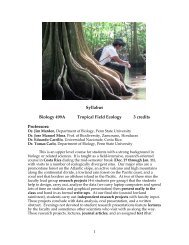Biol 436 Population Ecology and Global Climate Change
Biol 436 Population Ecology and Global Climate Change
Biol 436 Population Ecology and Global Climate Change
You also want an ePaper? Increase the reach of your titles
YUMPU automatically turns print PDFs into web optimized ePapers that Google loves.
<strong>Biol</strong> <strong>436</strong> <strong>Population</strong> <strong>Ecology</strong> <strong>and</strong> <strong>Global</strong> <strong>Climate</strong> <strong>Change</strong><br />
Fall 2010<br />
215 Thomas Bldg., T & Th 9:45 – 11:00<br />
Instructor: Prof. Eric Post<br />
Email: esp10@psu.edu; phone 865-1556<br />
Office hours: 325 Mueller, Tuesdays from 11:00 a.m. – 12:00 p.m.<br />
Course Syllabus (subject to minor modifications)<br />
Text: There is no required text for this course, but lectures will be drawn from material in <strong>Population</strong> <strong>Ecology</strong>,<br />
3 rd edition. M. Begon, M. Mortimer, & D. J. Thompson; The Evolution of Life Histories, S.C. Stearns; The<br />
Descent of Man <strong>and</strong> Selection in Relation to Sex, C. Darwin; <strong>and</strong> The Theory of Sex Allocation, E.L. Charnov,<br />
as well as recent literature on climate change. NOTE: The assigned readings pertain to journal articles that<br />
will supplement discussion during lectures. You will also be responsible for articles appear in the Science<br />
Tuesday section of the New York Times. Material from NY Times articles will supplement discussions.<br />
Grades will be based on three exams (20% each), a brief in-class presentation (20%), <strong>and</strong> regular in-class<br />
participation on Special Topics (20%). To get full credit for Special Topics, you must submit to me via<br />
email a brief written evaluation of each week’s topic, or that week’s NY Times science article,<br />
summarizing only its effective <strong>and</strong> ineffective points. Each week’s Special Topics evaluation is due by the<br />
end of the day on that topic’s date. Students will be required to follow the guidelines concerning academic<br />
integrity as described in the Penn State University Faculty Senate Policy 49-20<br />
(http://www.psu.edu/dept/ufs/policies/47-00.html#49-20).<br />
Date Topic Suggested Reading<br />
Section 1: <strong>Population</strong> Characteristics<br />
Aug. 24 Introduction<br />
Aug. 26 The major climate systems <strong>and</strong> IPCC change<br />
scenarios<br />
Aug. 31 Special Topic: <strong>Global</strong> warming – or natural<br />
variation?<br />
Sept. 2 Ice Age extinctions<br />
Hansen, J. et al. 2006. PNAS 103:14,288-<br />
14,293.<br />
Guthrie, R.D. 2006. Nature 441:207-209<br />
Sept. 7 Special Topic: Will warming lead to a new<br />
Ice Age?<br />
Sept. 9 Life history variation <strong>and</strong> phenology Root et al. 2003. Nature 421:57-60<br />
Sept. 14 Special Topic: How sensitive is the Arctic?<br />
Sept. 16 Threatened & Endangered Species Unit I<br />
Sept. 21 Sex differences <strong>and</strong> implications for response to<br />
climate change<br />
Møller, A.P. 2004. <strong>Global</strong> <strong>Change</strong><br />
<strong>Biol</strong>ogy 10: 2028-2035<br />
1
Sept. 23 Special Topic: Role of humans in Earth’s<br />
environment<br />
Sept. 28 Exam I<br />
Section 2:<br />
Single-species dynamics<br />
Sept. 30 Special Topic: Does a little warming really<br />
matter?<br />
Oct. 5 *Resources, reproduction, <strong>and</strong> trophic<br />
mismatch<br />
Oct. 7 Special Topic: Fossil Fuels<br />
Oct. 12<br />
The niche concept <strong>and</strong> climate change<br />
Oct. 14 Special Topic: What can we do about<br />
warming?<br />
Oct. 19 Threatened & Endangered Species Unit II<br />
Oct. 21 Bioclimatic envelope modeling <strong>and</strong> species’<br />
range shifts<br />
Post et al. 1999. PNAS 96:4467-4471<br />
Both et al. 2006. Nature 441:81-83<br />
Tingley et al. 2009. PNAS 106:19,637-<br />
19,643.<br />
Davis et al. 1998. Nature 391:783-786.<br />
Oct. 26 <strong>Population</strong> dynamics <strong>and</strong> stability Post & Forchhammer 2002. Nature<br />
420:168-171<br />
Oct. 28<br />
Section 3: Multi-species dynamics<br />
Exam II<br />
Nov. 2 Special Topic: Inter-connected changes<br />
Nov. 4 Communities dynamics <strong>and</strong> stability<br />
Nov. 9 Special Topic: Biodiversity crisis<br />
Moritz et al. 2008. Science 322:261-264.<br />
Nov. 11 The importance of species interactions Post & Pedersen 2008. PNAS 105:12,353-<br />
12,358.<br />
Nov. 16 Special Topic: Extinctions<br />
Nov. 18 *Ecosystem function<br />
Nov. 30 Threatened & Endangered Species Unit III<br />
Dec. 2 Extinction risk from climate change<br />
Dec. 7 Special Topic: Politics of <strong>Climate</strong> <strong>Change</strong><br />
Dec. 9 Exam III<br />
Zhao & Running 2010. Science 329:940-<br />
943.<br />
Thomas et al. 2004 Nature 427:145-148<br />
2
Threatened & Endangered Species units<br />
You will be assigned a species early in the semester, <strong>and</strong> will work in groups of 3 throughout the semester to<br />
identify the vulnerability of a given species to climate change <strong>and</strong> other stressors. On three occasions, one<br />
member of the group will make a brief presentation on your species; i.e., you will make one presentation (5 –<br />
10 minutes long). The objective for the class as a whole is to determine which species is/are most likely to be<br />
adversely affected by climate change <strong>and</strong> other stressors, <strong>and</strong> which is/are least likely to be affected. To make<br />
these determinations, you will work outside of class (alone or in groups) to rank your species according to<br />
several variables provided below.<br />
Unit I: Baseline vulnerability (presented Sept. 16)<br />
Rank your species according to:<br />
1. Current population size: 1: n < 100; 2: 100 < n < 1000; 3: n > 1000<br />
2. <strong>Population</strong> trend: 1: declining; 2: stable; 3: increasing<br />
3. Range trend: 1: declining; 2: stable; 3: increasing<br />
4. Future stressors (non-climate): 1: increasing; 2: stable; 3: declining<br />
5. Generation time: 1: t > 5 years; 2: 5 > t > 2; 3: t < 2<br />
6. Future vulnerability to natural stressors: 1: highly vulnerable; 2: vulnerable; 3: not vulnerable<br />
Unit II: Vulnerability to climate change (presented Oct. 19)<br />
Rank your species according to:<br />
1. Vulnerability to temperature change: 1: adverse; 2: insensitive; 3: beneficial<br />
2. Vulnerability to precipitation change: 1: adverse; 2: insensitive; 3: beneficial<br />
3. Dispersive capacity: 1: low; 2: moderate; 3: high<br />
4. Degree of habitat specialization: 1: highly specialized; 2: moderately specialized; 3: generalist<br />
5. Probable habitat loss due to climate change: 1: loss; 2: no change; 3: gain<br />
6. Availability of habitat in new range: 1: none; 2: limited extent; 3: large extent<br />
Unit III: Evaluating overall vulnerability (presented Nov. 30)<br />
Here you will present a synthesis of the above rankings in the following matrix format. You will attempt to<br />
identify the most critical combinations of vulnerability for your species. You will also categorize your species<br />
overall as: critically vulnerable, highly vulnerable, less vulnerable, least vulnerable, or likely to benefit from<br />
climate change. How you arrive at your conclusion is up to you to decide, but be sure you can explain<br />
your thinking.<br />
<strong>Climate</strong><br />
<strong>Change</strong><br />
Vulnerabilities<br />
1<br />
2<br />
3<br />
4<br />
5<br />
6<br />
Baseline Vulnerabilities<br />
1 2 3 4 5 6<br />
3


